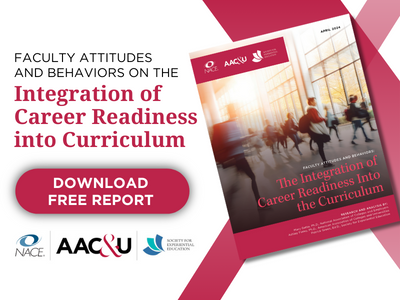In recent years, the overall knowledge rate of Davidson College’s first-destination survey (FDS) has been near or above 90%. Davidson has found several steps—such as getting an early start, using texts, and providing tailored information—to be helpful in attaining and maintaining a high FDS knowledge rate.
Dalton Langdon, assistant director for career development, science and pre-professional health, in the Betty and B. Frank Matthews II Center for Career Development, explains that Davidson's overall FDS knowledge rate is a combination of the “student response rate” (the information provided by students through the graduate survey, which is preferred) and the “knowledge rate” (the information on graduates searched for and compiled by career development staff).
Davidson’s FDS process starts at the end of March when the Matthews Center joins other campus departments during an event called “Senior Salute.” The center sends out the survey to seniors that morning via email; the message also encourages them to visit the Matthews Center’s table at Senior Salute to fill out the survey on an iPad.
“This year, we had 131 out of our 462 seniors complete the survey during Senior Salute,” Langdon notes.
“Getting an early start has been beneficial for us as we start to get a count of how many students we are still looking for.”
Langdon maintains a spread sheet that tracks the FDS status and outcome of each graduate. He says that getting graduating students’ personal emails before they depart campus is critical.
“While Davidson’s student email addresses remain active for one year after students graduate, we find that they tend not to check their school email anymore,” Langdon explains.
Email messages are scheduled through Davidson’s CMS at various intervals, starting during the summer following graduation.
“We try to tailor the message to the students so they don’t feel as though they are part of some mass email campaign,” Langdon explains.
“We’ll explain the FDS and why their participation is important. We explain to seniors that we use the information they provide as outcomes data, to then inform underclass years of possible career paths post-graduation.”
Even more efficient is sending reminders via text messages.
“Texting is very helpful as long as the [phone] numbers are accurate,” Langdon notes.
“Phone calls have become increasingly ineffective because people rarely answer calls anymore and calls tend to just go straight to voicemail.”
With texts, Langdon uploads names and numbers associated with those names into a mass texting program that sends individual text messages.
“It spoofs the number so the message isn’t coming from your personal number, but is an area code and number they recognize. Using it, we could send 300 individual text messages in three minutes.”
Efforts ramp up at the end of the summer and the beginning of the fall semester as Langdon and his team supplement these efforts by checking graduates’ social media profiles (first LinkedIn, then Instagram and Facebook); inquiring at campus offices, such as those for international students or student-athletes; or asking academic departments and faculty members about the status of their graduates.
He has several recommendations for attaining a high and consistent FDS knowledge rate:
- It's a marathon, not a sprint (and it’s not just your race)— Langdon says FDS data collection needs to have a steady pace starting before graduation and extending to the survey deadline. He tries to find a balance of his responsibilities and fit in FDS outreach, inquiry, and research when he is likely to get the best results. He also strongly recommends involving others in the process— such as student workers and/or other career center staff members—so it is more comprehensive and less all-consuming for the point person.
- Use the data you have collected to help your efforts—Davidson uses its FDS data to create an annual report that is shared with the president, board of trustees, and on the Matthews Center’s website. In addition, a printout of the key data is handed to families of incoming students during tours. Other uses include providing tailored data to students during meetings students and career center programming, and in subsequent FDS campaigns.
“I don’t know that students understand the FDS and why they should participate,” Langdon says.
“They’re already inundated with other surveys, so why should they take 10 or 15 minutes of their time to do this one? We can help them to understand the value and why it’s important that they participate by customizing our messages and the FDS data we send to them. It’s important to showcase the results to them.”




